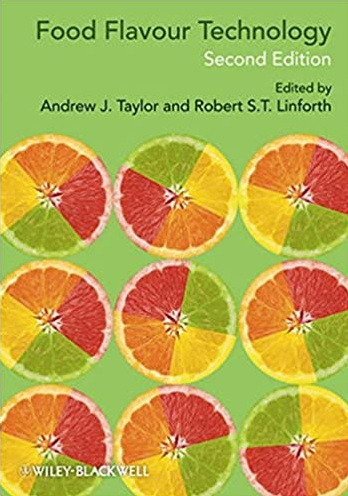Food Flavour Technology 2nd Edition by Andrew J. Taylor, ISBN-13: 978-1405185431
[PDF eBook eTextbook]
- Publisher: Wiley-Blackwell; 2nd edition (February 22, 2010)
- Language: English
- 378 pages
- ISBN-10: 1405185430
- ISBN-13: 978-1405185431
Food flavour technology is of key importance for the food industry. Increasingly, food products must comply with legal requirements and conform to consumer demands for “natural” products, but the simple fact is that, if foods do not taste good, they will not be consumed and any nutritional benefit will be lost. There is therefore keen interest throughout the world in the production, utilisation and analysis of flavours.
The second edition of this successful book offers a broad introduction to the formulation, origins, analysis and performance of food flavours, updating the original chapters and adding valuable new material that introduces some of the newer methodologies and recent advances.
The creation of flavourings is the starting point for the book, outlining the methodology and constraints faced by flavourists. Further constraints are considered in a chapter dealing with international legislation. The origins of flavours are described in three chapters covering thermal generation, biogeneration and natural sources, keeping in mind the adjustments that manufacturers have had to make to their raw materials and processes to meet the demand for natural products whilst complying with cost issues. Delivery of flavours using encapsulation or through an understanding of the properties of the food matrix is described in the next two chapters, and this section is followed by chapters describing the different ways to analyse flavours using instrumental, modelling and sensory techniques. The book is aimed at food scientists and technologists, ingredients suppliers, quality assurance personnel, analytical chemists and biotechnologists.
Table of Contents:
List of contributors Preface
1 Creating and formulating flavours
John Wright
1.1 Introduction
1.2 Interpreting analyses
1.3 Flavour characteristics
1.4 Applications
1.5 Flavour forms
1.6 Production issues
1.7 Regulatory affairs
1.8 A typical flavour
1.9 Commercial considerations
1.10 Summary
References
2 Flavour legislation
Jack Knights
2.1 Introduction
2.2 Methods of legislation
2.3 Legislation in the United States
2.4 International situation: JECFA
2.5 Council of Europe
2.6 European community
2.7 Current EU Situation and the future
References
3 Basic chemistry and process conditions for reaction flavours with particular focus on Maillard-type reactions
Josef Kerler, Chris Winkel, Tomas Davidek and Imre Blank
3.1 Introduction
3.2 General aspects of the Maillard reaction cascade
3.3 Important aroma compounds derived from Maillard reaction in food and process flavours
3.4 Preparation of process flavours
3.5 Outlook
References
4 Biotechnological flavour generation
Ralf G. Berger, Ulrich Krings and Holger Zorn
4.1 Introduction
4.2 Natural flavours: market situation and driving forces
4.3 Advantages of biocatalysis
4.4 Micro-organisms
4.5 Enzyme technology
4.6 Plant catalysts
4.7 Flavours through genetic engineering
4.8 Advances in bioprocessing
4.9 Conclusion
References
5 Natural sources of flavours
Peter S.J. Cheetham
5.1 Introduction
5.2 Properties of flavour molecules
5.3 Dairy flavours
5.4 Fermented products
5.5 Cereal products
5.6 Vegetable sources of flavour
5.7 Fruit
5.8 Other flavour characteristics
5.9 Fragrance uses
5.10 Conclusion
References
6 Useful principles to predict the performance of polymeric flavour delivery systems
Daniel Benczédi
6.1 Overview
6.2 Introduction
6.3 Compatibility and cohesion
6.4 Sorption and swelling
6.5 Diffusion and release
References
7 Delivery of flavours from food matrices
Saskia M. van Ruth and Jacques P. Roozen
7.1 Introduction
7.2 Flavour properties
7.3 Thermodynamic aspects of flavour delivery
7.4 Kinetic aspects of flavour delivery
7.5 Delivery systems: food technology applications
7.6 Conclusions
References
8 Modelling flavour release
Rob Linforth
8.1 Introduction
8.2 Equilibrium partition models
8.3 Dynamic systems
8.4 In vivo consumption
8.5 Conclusion
References
9 Instrumental methods of analysis
Gary Reineccius
9.1 Analytical challenges
9.2 Aroma isolation
9.3 Selection of aroma isolation method
9.4 Aroma isolate fractionation prior to analysis
9.5 Flavour analysis by gas chromatography
9.6 Flavour analysis by HPLC
9.7 Identification of volatile flavours
9.8 Electronic ‘noses’
9.9 Summary
References
10 On-line monitoring of flavour processes
Andrew J. Taylor and Rob S.T. Linforth
10.1 Introduction
10.2 Issues associated with in vivo monitoring of flavour release
10.3 Pioneers and development of on-line flavour analysis
10.4 On-line aroma analysis using chemical ionisation techniques
10.5 Analysis of tastants using direct mass spectrometry
10.6 Applications
10.7 Future
References
11 Sensory methods of flavour analysis
Ann C. Noble and Isabelle Lesschaeve
11.1 Introduction
11.2 Analytical tests
11.3 Consumer tests
11.4 Sensory testing administration
11.5 Selection and training of judges
11.6 Statistical analysis of data
11.7 Relating sensory and instrumental flavour data
11.8 Summary
References
12 Brain imaging
Luca Marciani, Sally Eldeghaidy, R.C. Spiller, P.A. Gowland and S.T. Francis
12.1 Introduction
12.2 Cortical pathways of taste, aroma and oral somatosensation
12.3 Imaging of brain function
12.4 Brain imaging of flavour
12.5 Future trends
References
Index
What makes us different?
• Instant Download
• Always Competitive Pricing
• 100% Privacy
• FREE Sample Available
• 24-7 LIVE Customer Support






Reviews
There are no reviews yet.